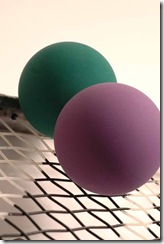 When I play racquetball with my buddy Chris every once in a while we call a screen shot. Meaning the other player got in the way and you were unable to get to the ball because of their positioning.
When I play racquetball with my buddy Chris every once in a while we call a screen shot. Meaning the other player got in the way and you were unable to get to the ball because of their positioning.
We are pretty fair about when we call a screen, but because of my uncertainty, I decided to look it up and see what the racquetball rules say.
The rules are relatively clear, but I thought I would go take a peak on a racquetball forum, in this case I checked out meetandplay.com.
I found the following post which seems to clear things up pretty well:
There are two types of Screens:
1) Screens Serves (Faults).
2) Screens Hinders during a Rally after the Serve (Replay Hinder, Penalty Hinder or No Replay-No Penalty Call).
OK, sounds like you understand the Screen Serve.
The “Screen” during a rally, occurs when a “non-hitter opponent” is standing between the hitter and where the ball is/went.
Position of the hitter is not the issue, since the hitter could be in any position on the court, good or bad, intentional or not.
But...
Like any “Hinder”, the hitter must have had a “chance” to make the return for any type of Hinder to be called (Replay or Penalty).
If the hitter couldn't have had a “chance” for a return, then no Hinder occurred, even though the hitter couldn't see the ball.
This is because there are situations when the non-hitter is not in the way, and the hitter can see whats going on- and still is not able to make a return!
How To Determine if a Screen occurred?
Gotta playback the rally in your head after the rally ends, then determine the ability of the hitter to have a “chance” to make the return, if the opponent wasn't in the way!
By The Way
Players often have different “Calls” for this situation, based on their ability levels.
A beginner player, a “slow” (sometimes an overweight or out of shape experienced player), or a player with poor anticipation may not be able to react and/or move as quick as a more experienced player, or a player in better shape.
Yes, there will be arguments when a player questions why the same “situation” has a Hinder Replay favoring his opponent, but no Replay Hinder in their favor?
Simple answer, the players have different abilities on the court (this may, or may not mean skill ability, just reaction or movement ability).
 There are many different types of shots in racquetball, many of which I will cover over time when I'm less lazy, but the shot I am going to talk about today is called a pinch shot.
There are many different types of shots in racquetball, many of which I will cover over time when I'm less lazy, but the shot I am going to talk about today is called a pinch shot.






